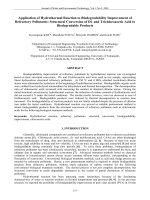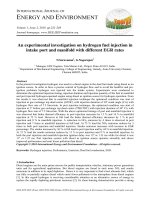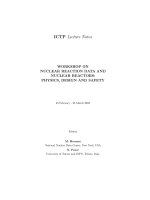Equilibrium reaction rates
Bạn đang xem bản rút gọn của tài liệu. Xem và tải ngay bản đầy đủ của tài liệu tại đây (104.23 KB, 8 trang )
SAT Chemistry Practice Questions
Chapter 7.
EQUILIBRIUM & REACTION RATES
Question 1. What is the term for the energy necessary for reactants to achieve the transition state
and
form products?
A. heat of reaction
B. energy barrier
C. rate barrier
D. collision energy
E. activation energy
Question 2. Which of the following stresses would shift the equilibrium to the left for the following
chemical system at equilibrium heat + 6H2O (g) + 2N2 (g)
4NH3 (g) + 3O2 (g)?
A. Increasing the concentration of H2O
B. Decreasing the concentration of NH3
C. Increasing the concentration of O2
D. Increasing the reaction temperature
E. Decreasing the concentration of O2
Question 3. Which component of the reaction mechanism results in the net production of free
radicals?
I. initiation
II. propagation
III. termination
A. I only
B. II only
C. III only
D. II and III only
E. I and III only
Question 4. Nitrogen monoxide reacts with bromine at elevated temperatures according to the
equation
2NO (g) + Br2 (g) → 2NOBr (g)
What is the rate of consumption of Br 2 (g) if, in a certain reaction mixture, the rate of formation of
NOBr (g) was 4.50 × 10 mol L-1 s-1
A. 3.12 × 10-4 mol L-1 s-1
B. 8.00 × 10-4 mol L-1 s-1
C. 2.25 × 10-4 mol L-1 s-1
D. 4.50 × 10-4 mol L-1 s-1
E. 4.00 × 10-4 mol L-1s-1
Question 5. For a collision between molecules to result in a reaction, the molecules must possess
both a favorable orientation relative to each other and:
A. be in the gaseous state
B. adhere for at least 2 nanoseconds
C. have a certain minimum energy
D. exchange electrons
E. be in the liquid state
Question 6. What is the term for a substance that allows a reaction to proceed faster by lowering
the energy of activation?
A. rate barrier
B. energy barrier
C. collision energy
D. activation energy
E. catalyst
Question 7. Reaction rates are determined by all of the following factors, EXCEPT:
A. orientation of collisions between molecules
Mã đề 000
Trang 1/8
SAT Chemistry Practice Questions
B. spontaneity of the reaction
C. force of collisions between molecules
D. number of collisions between molecules
E. the activation energy of the reaction
Question 8. For the combustion of ethanol (C2H6O) to form carbon dioxide and water, what is the
rate at which carbon dioxide is produced if the ethanol is consumed at a rate of 3.0 Ms?
A. 1.5 M s-1
B. 12.0 M s-1
C. 60 M s-1
D. 9.0 M s-1
E. 10.0 M s-1
Question 9. If the heat of reaction is endothermic, which of the following is always true?
A. The energy of the reactants is less than the products
B. The energy of the reactants is greater than the products
C. the reaction rate is slow
D. The reaction rate is fast
E. None of the above
Question 10. Most reactions are carried out in liquid solution or in the gaseous phase, because in
such situations:
A. kinetic energies of reactants are lower
B. reactant collisions occur more frequently
C. activation energies are higher
D. reactant activation energies are lower
E. reactant collisions occur less frequently
Question 11. Why might increasing the concentration of a set of reactants increase the rate of
reaction?
A. The rate of reaction depends only on the mass of the atoms and therefore increases as you
increase the mass of the reactants
B. The concentration of reactants is unrelated to the rate of reaction
C. There is an increased ratio of reactants to products
D. There is an increased probability that any two reactant molecules collide and react
E. None of the above
Question 12. What is the term for a dynamic state of a reversible reaction in which the rates of the
forward and reverse reactions are equal?
A. dynamic equilibrium
B. rate equilibrium
C. reversible equilibrium
D. concentration equilibrium
E. chemical equilibrium
Question 13. Which conditions would favor the reaction to completion?
2N2 (g) + 6H2O (g) + heat
4NH3 (g) + 3O2 (g)
A. Increase reaction temperature
B. Continual addition of NH3 gas to the reaction mixture
C. Decrease the pressure on the reaction vessel
D. Continual removal of N2 gas
Mã đề 000
Trang 2/8
SAT Chemistry Practice Questions
E. Decreases reaction temperature
Question 14. The reaction ·OH + H2
→
H2O + H· is an example of a free radical:
I. initiation
II. propagation
III. termination
A. I only
B. II only
C. III only
D. II and III only
E. I and II only
Question 15. In a particular study of the reaction described by the equation, what is the rate of
consumption of CH4O (g) if the rate of consumption of O2 (g) is 0.400 mol L-1 s-1 ?
2CH4O (g) + 3O2 (g) → 2CO2 (g) + 4H2O (g)
-1 s-1
A. 0.150 mol L
B. 0.267 mol L-1 s-1
C. 0.333 mol L-1 s-1
D. 0.550 mol L-1 s-1
E. 0.500 mol L-1 s-1
Question 16. Which of the following statements about "activation energy" is correct?
A. Activation energy is the energy given off when reactants collide
B. Activation energy is high for reactions that occur rapidly
C. Activation energy is low for reactions that occur rapidly
D. Activation energy is the maximum energy a reacting molecule may possess
E. Activation energy is low for reactions that occur slowly
Question 17. What is the term for the principle that the rate of reaction is regulated by the
frequency. energy and orientation of molecules striking each other?
A. orientation theory
B. frequency theory
C. energy theory
D. collision theory
E. rate theory
Question 18. Which of the following statements can be assumed to be true about how reactions
occur?
A. Reactant particles must collide with each other
B. Energy must be released as the reaction proceeds
C. Catalysts must be present in the reaction
D. Energy must be absorbed as the reaction proceeds
E. The energy of activation must have a negative value
Question 19. Given the rate = k[A]2[B]4 what is the order of the reaction?
A. I
B. 2
C. 4
D. 6
E. 8
Question 20. What is the equilibrium constant expression (Ksp) for slightly soluble silver sulfate in
an aqueous solution Ag2SO4 (s)
2Ag+ (aq) + SO42- (aq)?
A. Ksp = [Ag+] [SO42-]2
B. Ksp = [Ag+]2 [SO42-]/[Ag2SO4]
C. Ksp = [Ag+] [SO42-]
D. Ksp = [Ag+]2 [SO42-]2/[Ag2SO4]
E. Ksp = [Ag+]2 [SO42-]
Question 21. The minimum combined kinetic energy reactants must possess for collisions to result
in a reaction is:
Mã đề 000
Trang 3/8
SAT Chemistry Practice Questions
A. orientation energy
B. activation energy
C. collision energy
D. dissociation energy
E. bond energy
Question 22. Why does a glowing splint of wood burn only slowly in air, but rapidly in a burst of
flames when placed in pure oxygen?
A. A glowing wood splint is actually extinguished within pure oxygen because oxygen inhibits
the smoke
B. Pure oxygen is able to absorb carbon dioxide at a faster rate
C. Oxygen is a flammable gas
D. There is an increased number of collisions between the wood and oxygen molecules
E. There is a decreased number of collisions between the wood and oxygen
Question 23. What is the term for a reaction that proceeds by absorbing heat energy?
A. isothermal reaction
B. exothermic reaction
C. endothermic reaction
D. all of the above
E. none of the above
Question 24. All of the following factors may shift the position of equilibrium, EXCEPT:
A. decreasing reaction temperature
B. doubling the pressure
C. increasing reaction temperature
D. reducing reaction volume
E. addition of a catalyst
Question 25. Which factor does NOT describe activated complexes?
A. May be chemically isolated
B. Decompose rapidly
C. Have specific geometry
D. Are extremely reactive
E. At the high point of the reaction profile
Question 26. A 10-mm cube of copper metal is placed in 250 mL of 12 M nitric acid at 25 °C and
the reaction below occurs:
Cu (s) + 4H+ (aq) + 2NO3- (aq) → Cu2+ (aq) + 2NO2 (g) + 2H2O (l)
At a particular instant in time, nitrogen dioxide is being produced at the rate of 2.6 × 10 -4 M/min. At
this same instant, what is the rate at which hydrogen ions are being consumed?
A. 2.6 × 10-4 M/min
B. 1.0 × 10-3 M/min
C. 1.3 × 10-4 M/min
D. 5.2 × 10-4 M/min
E. 6.5 × 10-5 M/min
Question 27. If, at equilibrium, reactant concentrations are slightly smaller than product
concentrations, the equilibrium constant would be:
A. slightly greater than 1
B. slightly lower than 1
C. << 1
D. >> 1
E. equal to zero
Question 28. Which of the following influences the rate of a chemical reaction?
A. Collision orientation
B. Collision energy
Mã đề 000
Trang 4/8
SAT Chemistry Practice Questions
C. Collision frequency
D. None of the above
E. All of the above
Question 29. Which of the following affects all reaction rates?
A. Temperature of the reactants
B. Presence of a catalyst
C. Concentrations of the reactants
D. All are correct
E. None affect the rates
Question 30. If the rate law = k[A]1/2[B], which of the following can be concluded about the
reaction?
A. Reaction mechanism does not occur in a single step
B. The rate of A is half the rate of B
C. For every molecule of B, two molecules of A react
D. For every molecule of A, two molecules of B react
E. None are true
Question 31. Which of the changes has no effect on the equilibrium for the reversible reaction:
SO3 (g) + NO (g) + heat
SO2 (g) + NO2 (g)
A. add a catalyst
B. add helium gas
C. increase volume
D. decrease volume
E. all of the above
Question 32. The expression for the equilibrium constant, K., for the reaction below is:
4NH3 (g) + 5O2 (g)
4NO (g) + 6H2O (g)
4
6
A. Keq = [NO] [H2O] / [NH3]4[O2]5
B. Keq = [NH3]4[O2]5 / [NO]4[H2O]6
C. Keq = [NO][H2O] / [NH3][O2]
D. Keq = [NH3][O2] / [NO][H2O]
E. Keq = [NH3]2[O2]5 / [NO]2 [H2O]3
Question 33. Why might increasing temperature alter the rate of a chemical reaction?
A. The molecules combine with other atoms at high temperature to save space
B. The density decreases as a function of temperature that increases volume and decreases
reaction rate
C. The molecules have a higher kinetic energy and have more force when colliding
D. The molecules are less reactive at higher temperatures
E. None of the above
Question 34. If the Eat is lowered, which of the following is always true?
A. The reaction is endothermic
B. The reaction is exothermic
C. The reaction proceeds slower
D. The reaction proceeds faster
E. None of the above
Question 35. If a reaction proceeds in several steps, the process with the highest activation energy
is the:
A. product formation step
B. activated complex step
C. transition step
D. favorable step
E. rate-determining step
Mã đề 000
Trang 5/8
SAT Chemistry Practice Questions
Question 36. What is the overall order of the reaction if the units of the rate constant for a particular
reaction are min1?
A. Zero
B. First
C. Second
D. Third
E. Fourth
Question 37. Which statement is NOT a correct characterization for a catalyst?
A. Catalysts are not consumed in a reaction
B. Catalysts do not actively participate in a reaction
C. Catalysts lower the activation energy for a reaction
D. Catalysts can be either solids, liquids or gases
E. Catalysts do not alter the equilibrium of the reaction
Question 38. What is the term for a reaction that proceeds by releasing heat energy?
A. Endothermic reaction
B. Isothermal reaction
C. Exothermic reaction
D. All of the above
E. None of the above
Question 39. For a chemical reaction to occur, all of the following must happen, EXCEPT:
A. reactant particles must collide with the correct orientation
B. a large enough number of collisions must occur
C. chemical bonds in the reactants must break
D. reactant particles must collide with enough energy for change to occur
E. chemical bonds in the products must form
Question 40. By convention, what is the equilibrium constant for step 1 in a reaction?
A. k1k+2
B. k1 + k+2
C. k-1
D. k1
E. k1/k-1
Question 41. What is the K, for calcium fluoride (CaF 2) if the calcium ion concentration in a
saturated solution is 0.00021 M?
A. Ksp = 3.7 × 10-11
B. Ksp = 2.3 × 10-12
C. Ksp = 4.4 × 10-8
D. Ksp = 8.8 × 10-8
E. Ksp = 9.3 x 10-12
Question 42. Which statement is correct concerning Reaction A if it releases 24 kJ/mole and has an
activation energy of 98 kJ/mole?
A. The overall reaction is exothermic with a high activation energy
B. The overall reaction is endothermic with a high activation energy
C. The overall reaction is exothermic with a low activation energy
D. The overall reaction is endothermic with a low activation energy
E. None of the above
Question 43. Why does dough rise faster in a warmer area when yeast in bread dough feed on sugar
to produce carbon dioxide?
A. The yeast tends to become activated with warmer temperatures, which is why baker's yeast is
best stored in the refrigerator
B. The rate of evaporation increases with increasing temperature
Mã đề 000
Trang 6/8
SAT Chemistry Practice Questions
C. There is a greater number of effective collisions among reacting molecules
D. Atmospheric pressure decreases with increasing temperature
E. Atmospheric pressure increases with increasing temperature
Question 44. Which is true before a reaction reaches chemical equilibrium?
A. The amount of reactants and products are equal
B. The amount of reactants and products are constant
C. The amount of products is decreasing
D. The amount of reactants is increasing
E. The amount of products is increasing
Question 45. Which of the changes shift the equilibrium to the right for the following system at
equilibrium:
N2 (g) + 3H2 (g)
2NH3 (g) + 92.94 kJ
Mã đề 000
Trang 7/8
SAT Chemistry Practice Questions
I. Removing NH3
II. Adding NH3
III. Removing N2
IV. Adding N2
A. I and III
B. II and III
C. II and IV
D. I and IV
E. None of the above
Question 46. Which is NOT an important condition for a chemical reaction?
A. The molecules must make contact
B. The molecules have enough energy to react once they collide
C. The reacting molecules are in the correct orientation to one another
D. None of the above
E. The molecules are in the solid, liquid or gaseous state
Question 47. The rate of a chemical reaction in solution can be measured in the units:
A. mol s L-1
B. s-2
C. mol L-1 s-1
D. L2 mol-1 s-1
E. sec L-1 mol-1
Question 48. Whether a reaction is exothermic or endothermic is determined by:
A. an energy balance between bond breaking and bond forming, resulting in a net loss or gain of
energy
B. whether a catalyst is present
C. the activation energy
D. the physical state of the reaction system
E. none of the above
Question 49. Which of the changes shifts the equilibrium to the right for the following reversible
reaction?
SO3 (g) + NO (g) + heat
SO2 (g) + NO2 (g)
A. decreasing temperature
B. increasing volume
C. increasing [SO3]
D. increasing [SO2]
E. adding a catalyst
Mã đề 000
Trang 8/8









